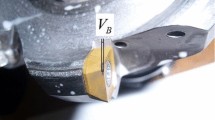Abstract
In this work, different artificial neural networks (ANN) are developed for the prediction of surface roughness (R a ) values in Al alloy 7075-T7351 after face milling machining process. The radial base (RBNN), feed forward (FFNN), and generalized regression (GRNN) networks were selected, and the data used for training these networks were derived from experiments conducted using a high-speed milling machine. The Taguchi design of experiment was applied to reduce the time and cost of the experiments. From this study, the performance of each ANN used in this research was measured with the mean square error percentage and it was observed that FFNN achieved the best results. Also the Pearson correlation coefficient was calculated to analyze the correlation between the five inputs (cutting speed, feed per tooth, axial depth of cut, chip’s width, and chip’s thickness) selected for the network with the selected output (surface roughness). Results showed a strong correlation between the chip thickness and the surface roughness followed by the cutting speed.















Similar content being viewed by others
References
L. H. S. Luong, T.A. Spedding “A Neural Network System for Predicting Machining Behavior”. J. Mater. Process. Technol. 52 585–591 (1995)
P.G. Benardos, G.C. Vosniakos. Prediction of Surface Roughness in CNC Face Milling Using Neural Networks and Taguchi′s Design of Experiments. Robot. Comput. Integr. Manuf. 18 343–354 (2002)
H Bisht, J Gupta, S.k. Pal, D. Chakraborty. “Artificial Neural Network Based Prediction of Flank Wear in Turning”. Int. J. Mater. Prod. Technol. Vol 22. No 4. (2005). 328–338
S. Pal, D. Chakraborty “Surface Roughness Prediction in Turning Using Artificial Neural Network”. Neural Comput. Appl. 14 319–324 (2005)
S. Basak, U.S. Dixit, and J.P. Davim (2007) Application of Radial Basis Function Neural Networks in Optimization of Hard Turning of AISI D2 Cold-Worked Tool Steel with Ceramic Tool. Proc. Inst. Mech. Eng. B: J. Eng. Manuf. 221(6):987–998
Z.W. Zhong, L.P. Khoo, and S.T. Han "Prediction of Surface Roughness of Turned Surfaces Using Neural Networks”. Int. J. Adv. Manuf. Technol. 28 688–693 (2006)
Oktem, H; Erzurumlu, T; Erzincanli, F. “Prediction of Minimum Surface Roughness in End Milling Mold Parts Using Neural Network and Genetic Algorithm”. Mater. Des. 27 735–744 (2006)
Lin, S.Y; Cheng, S.H and Chang, C.K. “Construction of a Surface Roughness Prediction Model for High Speed Machining”. J. Mech. Sci. Technol. 21 (2007) 1622–1629
Jesuthanam, C.P; Kumanan, S and Asokan, P. “Surface roughness Prediction Using Hybrid Neural Networks”. Mach. Sci. Technol. 11. 2007, 271–286
“Tool Life Testing in Milling. Part 1: Face Milling,” ISO 8688-1, International ISO Standard, 1989
A Diniz, J Filho, Influence of the Relative Position of Tool and Workpiece on Tool Life, Tool Wear and Surface Finish in the Face Milling Process. Wear Vol. 232 pp. 67–75(1999)
D. C. Montgomery. “Design and Analyses of Experiments”. Third edition. John Wiley & Sons (1997)
MATLAB User’s Guide
Franco, P; Estrems, M and Faura, F. Influence of Radial and Axial Runouts on Surface Roughness in Face Milling with Round Insert Cutting Tools”. Int. J. Machine Tools Manuf. 44 (2004), 1555–1565
Axente, D.A. and Dewes, R.C. Surface Integrity of Hot Work Tool Steel after High Milling Experimental Data and Empirical Models. J. Mater. Process. Technol. 127 (2002) 325–335
W Bouzid, Sai K“Roughness Modeling in Up-Face Milling”. Int. J. Adv. Manuf. Technol. 26 324–329 (2005)
Author information
Authors and Affiliations
Corresponding author
Rights and permissions
About this article
Cite this article
Muñoz-Escalona, P., Maropoulos, P.G. Artificial Neural Networks for Surface Roughness Prediction when Face Milling Al 7075-T7351. J. of Materi Eng and Perform 19, 185–193 (2010). https://doi.org/10.1007/s11665-009-9452-4
Received:
Revised:
Accepted:
Published:
Issue Date:
DOI: https://doi.org/10.1007/s11665-009-9452-4




